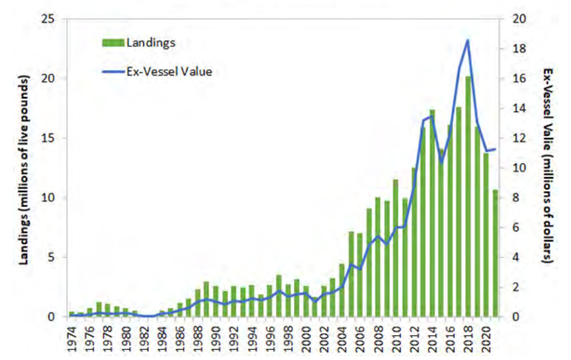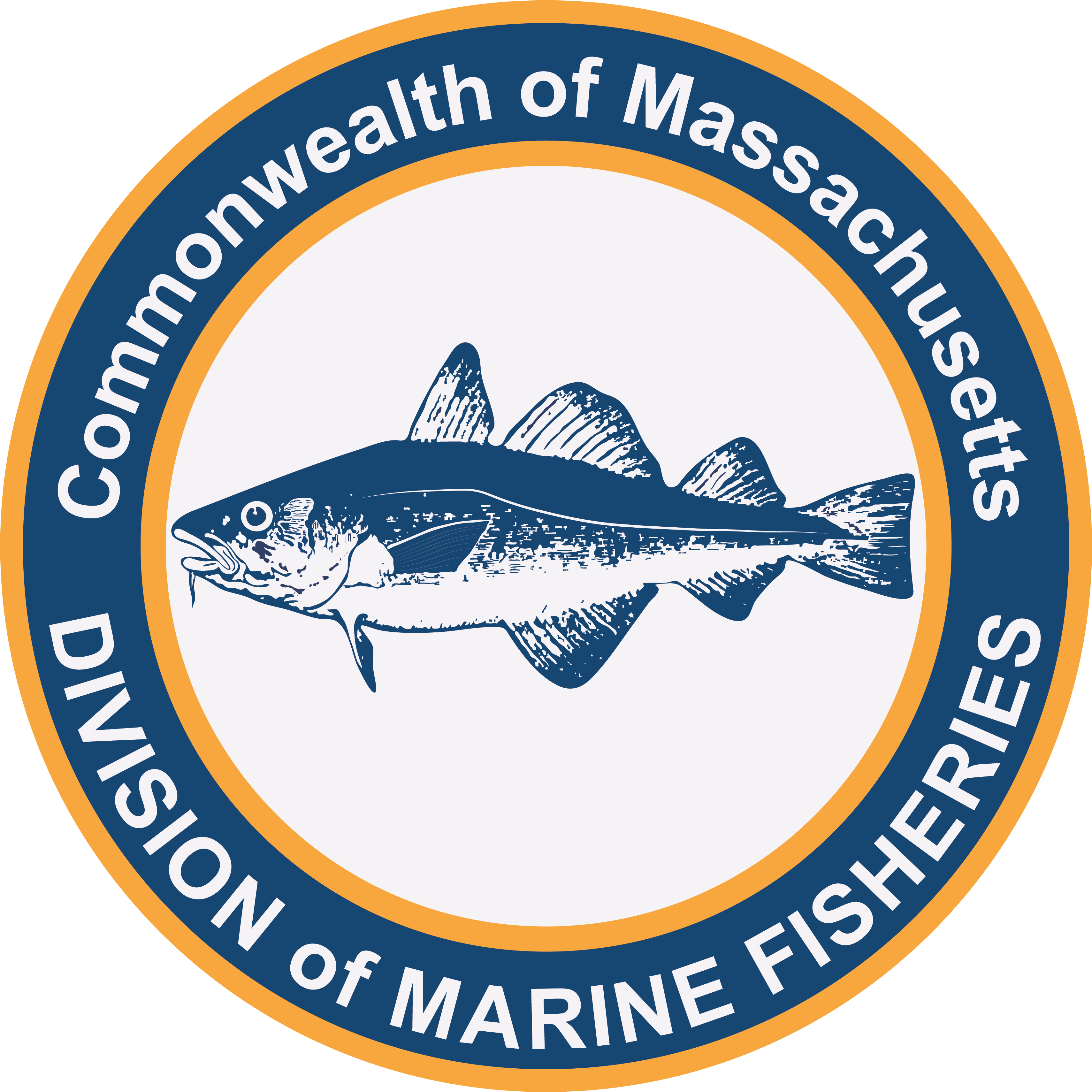- Division of Marine Fisheries

Jonah crabs (Cancer borealis) are part of a mixed crustacean fishery where permitted fishers can choose to target American lobster or Jonah crab with their traps. With the collapse of the Southern New England lobster stock in the early 2000s, some fishers switched from targeting lobster to targeting Jonah crab. The Jonah crab fishery has become increasingly important to Massachusetts. In 2022, the value of Jonah crabs landed in Massachusetts was $14 million, making it the 5th most valuable species in the state. More Jonah crabs are landed here than any other state, often accounting for more than 60% of annual U.S. landings. With the increased importance of the fishery, there is a greater need to evaluate stock status so fishery managers can make informed decisions.
The first U.S. Jonah crab stock assessment was approved for management use by the ASMFC Lobster/Jonah Crab Management Board at the ASMFC annual meeting in October. The stock assessment was conducted by a committee of state, federal, academic, and ASMFC scientists, and passed a rigorous peer review by external experts. The assessment committee evaluated fishery-independent (scientific surveys) and fishery-dependent data (commercial landings, effort, and observed catch) and divided Jonah crab into four stocks-Inshore Gulf of Maine, Offshore Gulf of Maine, Inshore Southern New England, and Offshore Southern New England/Georges Bank-based on regional differences in size at maturity, tagging/movement data, fishery exploitation, and regional trends of abundance.
There is a poor understanding of key Jonah crab life history characteristics, including estimates of size-at-age and how often adult crabs molt. There are also data set limitations, as many surveys did not start recording adequate data on Jonah crabs until after the release of the Jonah Crab Interstate Fishery Management Plan in 2015. Many surveys are not designed to catch Jonah crab, and therefore catch very few, and few surveys operate in offshore areas where most crabs are harvested. Because of these limitations, empirical indicators were used to assess the stocks instead of standard stock assessment models. Indicators derived from state and federal trawl surveys included recruit abundance, exploitable abundance, and adult abundance. Data from SCUBA-based settlement surveys (abundance of age-0 crabs) were also used as an abundance indicator. Commercial fishery data such as landings and fishing effort were used as fishery performance indicators. Current status (average of the last three years) for each indicator was evaluated relative to the indicator time series, and classified as positive, neutral, or negative.
Southern New England (SNE) Results
After steadily increasing for many years, overall coastwide landings peaked in 2018, and have declined since (see figure). Most of the commercial landings originate from offshore SNE, and the landings decline here has been most pronounced. Whether the cause of the landings decline is a function of crab abundance or market factors is unclear.
There are no annual settlement surveys in offshore SNE, so settlement conditions are unknown for this stock. Abundance indicators from the spring and fall show inconsistent patterns, which increases uncertainty and decreases confidence that either is accurately capturing abundance trends. Fishery performance indicators are also mixed, with some indicators in each of the three categories (negative, neutral, and positive).
Jonah crabs prefer cooler waters, which generally restricts inshore SNE crabs to deeper water found in Rhode Island Sound. Since surveys in this region cover mostly shallower, warmer waters, they do not overlap well with preferred Jonah crab habitat, which leads to limitations in the surveys’ ability to track abundance in this region. Thus, abundance for inshore SNE is generally unknown.
Results from the fishery performance indicators for inshore SNE are neutral to positive. The number of permits and the number of trips landing Jonah crab were neutral, while the proportion of trips landing Jonah crab was positive.
The stock assessment committee does not believe that current surveys in SNE are accurately tracking Jonah crab abundance, and therefore consider the status of the SNE stocks uncertain.
Gulf of Maine (GOM) Results
Surveys (settlement, state and federal trawl surveys) conducted in both the inshore GOM and offshore GOM regularly catch Jonah crab, and generally show similar trends. The consistency in trends amongst surveys leads to greater confidence that the surveys are good indicators of abundance.
For inshore GOM, while there have been declines in abundance from time series highs observed in the mid-2010s, abundance indicators are generally positive or neutral. All fisheries performance indicators for this stock are neutral because fishing effort has been consistently low in this region.
Similar to inshore GOM, offshore GOM abundance indicators show declines from recent time series highs in the mid-2010’s, but fisheries independent indicators and fishery dependent performance indicators remain generally positive or neutral. The proportion of trips landing Jonah crab in inshore GOM and offshore GOM are low, which can be attributed to the fishery in these regions targeting lobster instead of Jonah crab.
Jonah crab can be considered an underutilized resource in this region. The comparatively high value of lobster has kept Jonah crab landings in this region to modest levels. Data suggest there is potential for the Jonah crab fishery to expand in the GOM.
What’s Next?
While the stock assessment committee does not believe management action is necessary at this time, peer reviewers were concerned over preliminary reports showing declines in catch per unit effort (CPUE) for offshore SNE crabs landed in Rhode Island. However, updated analyses including Massachusetts data did not show the same decline. While intensive fishing effort appears to be localized, there are plenty of areas where fishing effort is minimal, despite higher levels of crab abundance. In areas where Jonah crab and lobster are both abundant, fishers generally target lobster due to the higher value per pound.
There is still a lot to learn about Jonah crab. The assessment identified many sources of uncertainty, which hinders a comprehensive understanding of Jonah crab stock status. The assessment includes research recommendations to help focus future work, including determining larval duration and dispersal, growth of adult crabs, and improving our ability to monitor population size in offshore SNE. Improvements in population monitoring and our understanding of Jonah crab life history will lead to better management advice. This was the first Jonah crab assessment conducted in the U.S. and will hopefully serve as a building block towards improved future assessments.
The peer review panel recommended updating the assessment in five years and conducting the next benchmark assessment in ten years to allow for time to complete tasks recommended by the stock assessment committee and peer reviewers. In the meantime, annual or semi-annual meetings will be held to monitor fishery performance indicators.
By Derek Perry and Dr. Tracy Pugh
